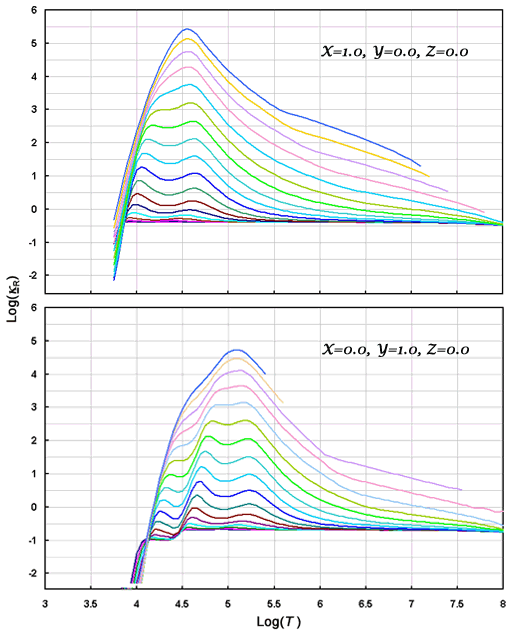
i. Variables.
| Iν(n) | Radiation specific intensity ergs cm−2 sec−1 strdn−1 Hz−1 |
| χν | Radiation extinction cm−1 |
| ην | Radiation emissivity ergs cm−3 sec−1 strdn−1 Hz−1 |
A. Considerations.
The specific intensity
Iν(n)
is the amount of radiant energy at frequency ν
passing in a beam in the direction n, per unit frequency,
per unit area, per steradian, per unit time. Thus:
Iν(n)
dν
dA dΩ dt has units
ergs (in cgs).
The intensity is reduced when the beam passes through absorbing particles and increased when the bean passes through emitting particles. Consider a beam passing through a volume dsdA containing different types of particles:

Because absorpion and emission are quantum mechanical processes, we may assume that upstream particles to not directly "shade" downstream particles, but only reduce/increase the average number of photons in the beam. None-the-less, there are enough particles in the volume that the probabilistic nature of the processes is not important, and we can assign cross sections to individual particles in a classical sense.
B. Terms in the Equation of Transfer.
The radiation energy coming into the volume within
dΩ is
Iν(n)
dν
dA dΩ
ergs/sec.
The energy change due to absorption by particles in the volume is:
dIab
dν
dA dΩ
= − Iν
dν
dΩ
dsdA nabaab(ν),
where dsdA nab is the total number of absorbers in the
volume, and aab(ν) is the
cross section of each absorber.
Thus we may write:
dIab =
− nab
aab(ν)
Iν ds.
Similarly, we may write for scattering out of the beam:
dIsc =
− nsc
asc(ν)
Iν ds.
Combining the above together, we have for the total extinction:
dIex =
− χν
Iν ds.
The energy change due to emission by particles in the volume is
generally written as:
dIem =
ην
ds,
where ην
is the volume emissivity (see units above).
The emissivity has many parts:
Stimulated emission: usually included as a negative contribution to
χν, since
it is proportional to Iν and
adds energy into the beam parallel to n.
Spontaneous emission: independent of
Iν.
Scattering: radiation scattered into the beam from other directions
and/or frequencies.
C. The Equation of Transfer along the direction n.
∂ Iν(n) /∂sn = − χν Iν(n) + ην
In geometries with azimuthal symmetry, e.g. plane parallel or spherical, the specific intensity is independent of the azimuth angle and varies only with depth and the zenith angle θ.

Let μ = cos(θ). Then ∂sn = dr/μ and the transfer equation becomes
μdIν(r,μ) /dr = − χν Iν(r,μ) + ην.
D. Angular Moments of the Specific Intensity
and the Equation of Transfer
In the definitions below, both the general form and the azimuth symmetry form of the angular moments are given.
b. The Mean Intensity:
Jν =
(1/4π)
∫
Iν(n)
dΩ.
Jν =
(1/2) ∫
Iν(μ)
dμ.
c. The Eddington Flux:
Hν =
(1/4π)
∫
Iν(n) n
dΩ.
Hν =
(1/2) ∫
Iν(μ)
μ
dμ.
In the general form, the Eddington flux is a vector. In the symmetric form, the flux is parallel to the radial direction.
The true energy flux is:
Fν =
4πHν =
l (r) /4&pir 2.
d. The Eddington Stress:
Kν =
(1/4π)
∫
Iν(n)
nn
dΩ.
Kν =
(1/2) ∫
Iν(μ)
μ 2
dμ.
In the general form, the stress is a second rank tensor. For isotropic radiation, K is diagonal with equal elements and may be replaced with a scalar, as in the case of isotropic pressure.
The radiation pressure is:
Pν =
(4π/c)Kν.
e. The equation of transfer.
Multiply by μ/2 and integrate over μ:
dKν /dr
= − χν Hν.
Notice that since the emissivity is isotropic, the integration of μη
over μ is zero.
E. The Diffusion approximation on the mass variable.
We may replace χν, which is rather density dependent,
with ρκν, where κν
is the opacity in units cm2/gram.
Then by applying the continuity equation relating m(r) to r,
we find
4πr 2dKν = − κν Hν dm.
Apply the diffusion approximation Kν = Jν/3 and
the optically thick approximation Jν = Bν:
4πr 2dBν
= − 3κν Hν dm.
Divide by κν and integrate over ν:
4πr 2
∫ (1/κν) dBν dν
= − 3l(m) dm /16π2r 2.
Now define the Rosseland mean opacity κ through:
∫ (1/κν)dBν dν ≡
(1/κ) ∫ dBν dν =
(1/κ) acT 3dT/π.
Finally, then:
64π 2r 4acT 3dT =
− 3κ l(m) dm
5.2. The Surface Boundary Condition
Consider stars with radiative envelopes below the surface
(e.g. Teff > 8000 K).
The temperature mass gradient will be
dT/ dm =
− 3κl
/64π 2r 4acT 3
Opacities will always be of the order of 1 cm 2/gram.
Consider a 5 Solar-mass star, with Teff ∼ 13000 K.
The gradient, in Solar-mass units, becomes:
dT/ dm ∼ 7×1012 deg/Solar-mass,
which is so steep that the calculation does not really know the difference
between 13000 K and zero K.
This result is called the radiative zero condition.
The effective temperature of the calculated star is then determined from the
surface luminosity and radius.
5.3 Opacities

The best Rosseland opacities are from either the Opacity Project or the
OPAL Project.
These opacities (and equation of state) appear in two-dimensional tables
[κ (logT, logR) where
R=ρ/T63] for a given composition.
One problem; while one might imagine a finite number of tables with various
ratios of X /Y, and/or ratios Y /C+O, nuclear evolution
results in almost infinite variations in composition. There is no easy way
to account for each opacity source independently due to the electron number.

Notice that nearly full ionization (as recorded by the electron scattering contribution)
occurs 0.5 or more in log(T ) earlier than the opacity peak, which occurs
when the Planck function moves over the ionization edge of the remnant un-ionized
population.